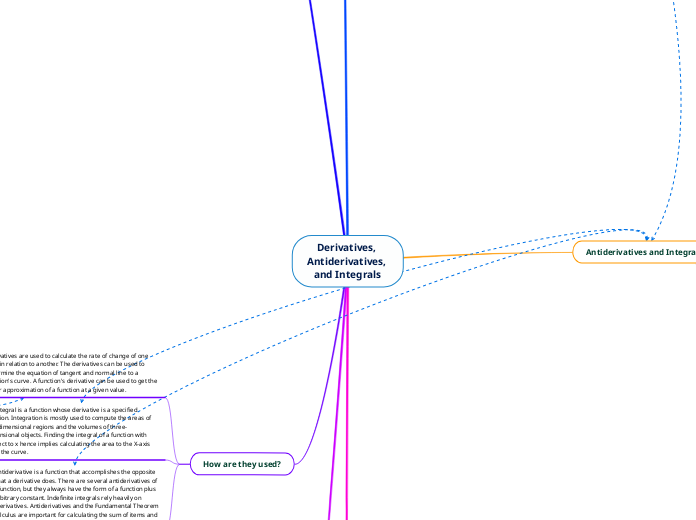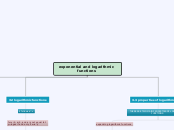Derivatives,
Antiderivatives,
and Integrals
Maxima and Minima
Mean Value Theorem
Then there's a number c in [a,b] such that
f'(c)=f(b)-f(a)/b-a
f(b)-f(a)=f'(c)(b-a)
CANNOT GO INTO THE NEGATIVES
Note: Rolle Theorem is a special case of MVT where fc) =f(b)-f(a)/b-a=0. It is all of MVT with added conditions that f|b|=f|a|
Let f be a function such that:
2. f is differentiable on [a,b]
1. f is continuous on a closed interval [a.b]
NO SHARP POINTS OR HOLES
Do not forget to test your x values
Critical Points
Critical Points does NOT GURANTEE max or min
Thus, we can rephrase Fermat's Theorem
if f has a local max or min at c, then c is called a critical point of f.
An exterior point c of the domain D of f such that, f'(c)=0 or f'(c) fails to exists
Locating Absolute Extreme Values on a closed interval
3. The largest value will be the absolute Max and the smallest will be the absolute min
2. Evaluate f at all critical numbers AND endpoints
1. Find all critical numbers (where f'(c)=0 or f'(c)=DNE)
And f(c) is the absolute minimum value of f on D. If f(c) is greater than or equal to f(x) for all x in D.
Fermat's Theorem
If f has a local max or min at c, f'(c) exists, then f'(c)=0
max and min are often referred as EXTREMA
Let f(c) be a number in the domain D of function. Then f(c) is the absolute maximum value of f on D if y is greater than or equal to y and f(c) is greater then or equal to f(x) for all x in D.
Extreme Value Theorem
If f is continuous on a closed interval [a,b], then f has an absolute maximum f(c) and minimum f(d) in [a,b].
c and d can be ENDPOINTS
Let c be a number in the domain D of a function f(c) is a local maximum value of f on D if f(c) is greater than or equal to f(x) for all values of x neighborhood around c.
Curve Sketching
Graphing Guidelines
7. Choose the appropriate window and graph
Make sure that you know what you are graphing
6. Determine concavity and inflection points
Derivative has to exist for it to change
IP is when the signs changes(negative and positive)
5. Identify extrema values.
Where the first derivative changes signs
4.Find the intervals of increasing and decreasing
Create number line to know where it is positive or negative
Critical points, y'=0
First Derivative
3. Find the Asymptotes
b. Vertical
denominator is 0
a. Horizontal
use limits to find
2. Find the intercepts
y-intercepts set x=0
x-intercepts set y=0
1. Identify the Domain/Interval of interest
log(x) is greater than 0
Even radicals is greater than or equal to 0
Denominator can not equal 0
Affect the Shape of a Graph
Concavity
Test for Concavity
If c is a point at which f''(x) changes sign at c, then f has an inflection point at c.
If f''(x) less than 0 on I, then f is concave down
If f''(x) greater than 0 on I, then f is concave up
if f is ontinuous at c and f changes concavity at c (from up to down or from down to up), then f has an inflection point at c.
if the graph of f lies below all of its tangents on an interval I, then it is said to be concave down.
Definition: If the graph of f lies above all of its tangents on interval I, then it is said to be concave up
Second Derivative Test
If f''(c)=0, then the second derivative test is inconclusive
If f''(c) is less than 0, then f has a local maximum.
Suppose f'' is continuous on an open interval containing c with f'(c)=0
First Derivative Test
Supposed f is continuous on an interval that contains a critical point c and is differentiable on the interval, except possibly c.
If f' positive on both sides of c or negative on both sides of c, then f has no extreme value at c.
if f' changes from negative to positive as x increases through c (from left to right), then f has a local minimum at c.
If f' changes sign from positive to negative as x increases through c (from left to right), then f has a local maximum at c.
There are infinite ways to make something true
A function f is decreasing on an interval I if f(x1)≥f(x2) whenever x1 ≥x2
A function f is increasing on an interval I if f(x1)⩽f(x2) whenever x1 ⩽ x2
How are they used?
An antiderivative is a function that accomplishes the opposite of what a derivative does. There are several antiderivatives of one function, but they always have the form of a function plus an arbitrary constant. Indefinite integrals rely heavily on antiderivatives. Antiderivatives and the Fundamental Theorem of Calculus are important for calculating the sum of items and how much they increased over time.
An integral is a function whose derivative is a specified function. Integration is mostly used to compute the areas of two-dimensional regions and the volumes of three-dimensional objects. Finding the integral of a function with respect to x hence implies calculating the area to the X-axis from the curve.
Derivatives are used to calculate the rate of change of one item in relation to another. The derivatives can be used to determine the equation of tangent and normal line to a function's curve. A function's derivative can be used to get the linear approximation of a function at a given value.
Derivatives
mtan=0
mtan<0
Zero Slope
mtan>0
Negative Slope
example:x=0
Slope
Positive Slope
Interpretations of Derivative
Physical interpretation, if the signed distance s from the orgin at time t of an object in linear motion is given by the position s=f(t), the derivative f'(t0) is the velocity of the object at time t0
Geometric interpretation if y=f(x), the derivative f'(c) is the slope of the tangent line to the graph of f at point (c,f(c))
4. The function does not exist at a.
Discontinuous means DNE
3. There is a vertical tangent at a.
Optimization
Example with steps
A rancher has 400 ft of fence for constructing three adjacent rectangular corrals. One side will be formed by the barn and requires no fence. What dimensions of the corrals will maximize the enclosed area?
400=8x
400/8=x
x=50
4(50)+y=400
y=200
Step 5: Use the First Derivative Test to find the absolute max or min. If necessary, check end points.
A'=400-8x
Step 4: Write the optimization equation expressed with a single variable
A=400x-4x^2
Step 3: Use the constraints to eliminate all but one independent variable.
A=(400-4x)x
Step 2: Identify the Optimization equation. Write it in terms of the variables from the constraints.
Step 1:Read the problem, draw a picture of diagram to repents all quantities and identify the constraints
4x+y=400
Generally involves a condition called the constraints and on optimization functions.
Optimization typically ask to find a max or min value of an object function
opposite reciprical
Linear Approximations
and Differentials
dy=f'(x)dx
If y=f(x), where f is differentiable function, then the differential dx is an independent variable . That is, dx can be given the value of any number. The differential dy is then defined in terms of dx by equation.
Implicit Differentiation
Find dy/dx of x^2+y^2=1
x^2(d/dx)+y^2(d/dx)=1(d/dx)
2x+2y=0
2x+2y(dy/dx)=0
2y(dy/dx)=-2x
dy/dx=-2x/2y
Answer:
dy/dx=-x/y
this is why the dx/dy notation is important?
The derivative of y with respect to x.
Equations that are not written in terms of one variable are called implicit equations. Some implicit equations cannot be written explicitly.
x^2+y^2=1
y^2+x^2+1
y=+/- square root (x^2+1)
half a circle
f(x)=f(a)+f'(a)(x-a)
f'(x)=f(x)-f(a)/x-a
is called the linear approximation or tangent line approximation of f at a. The linear function whose graph is this tangent line, that is L(x)=f(a)+f'(a)(x-a) is called the linearization of f at a.
a function will fail to be differentiable at a point a if
2. The function is discontinuous at a.
1. There is a casp or kink at a (bounce)
Derivative of a function
Higher Order Derivatives
f'(x) f''(x) f'''(x) f^4(x)
y' y'' y''' y^4
Dx D^2x D^3x D^nx
dy/dx d^2y/dx^2 d^3y/dx^3 d^ny/dx^n
The derivative of f is f(x) prime=dy/dx=limf(a+h)+f(a)/h
Provided the limit exists and a is in the domain of f. If f(x) prime exists, we say f is differentiable at a. If f is differentiable on every point of an interval I, we say that f is differentiable on I
mtan=limf(a+h)+f(a)/h
h→0
Derivative at a point
Find the tangent line to the function f(x)=-3x^2-5x+1 at (1,-7), Then find the normal line
First thing you are looking for is f(a+h)
-3(a+h)^2-5(a+h)+1
New Notation
Alternate definition
f on the interval [a,a+h]
From this we can get the tangent line passing through point (a,f(a))
Using the point-slope formula
mtan=point
msec=(f(x)-f(a))/x-a and mtan=limf(x)-f(a)/x-a
mtan=f(a) prime
x→a
Remember that a function f on the interval [a,x]
Hyperbolic Funtioncs
Derivatives of Hyperbolic Functions
d/dx(sechx)=-sech x tanh x
d/dx(coth x)= -csch^2 x
d/dx(csch x)= -cschxcoth x
d/dx(sinhx)=cosh x
d/dx(cosh x)=sinh x
d/dx(tanhx)= sech^2 x
Hyperbolic Identities
cosh^2x-sinh^2x=1
cosh(x+y)=coshxcoshy+sinhxsinhy
1-tanh^2x=sech^2x
sin^2x+cos^2x=1
cosh(-x)=-cosh(x)
sinh(x+y)=sinhxcoshy+coshysinhx
sinh(-x)=-sinh x
Hyperbolic functions arose from the comparison of semicircular regions.
Functions
sinh x = e^x-e^-x/2
Range: (-∞, ∞)
Domain:(-∞, ∞)
tanh x = sinh x/cosh x=e^x-e^-x/e^x+e^-x
Range: (-1,1)
Domain: (-∞,∞)
sech x = 1/cosh x = 2/e^x+e^-x
Range: (0,1]
Domain: (-∞, ∞)
coth x=cosh x/sinh x=e^x+e^-x/e^x-e^-x
Range: (-∞, -1)u(1,∞)
csch x = 1/sinh x = 2/e^x-e^-x
Range: (-∞, 0)u(0,∞)
Domain: (-∞, 0)u(0,∞)
cosh x = e^x+e^-x/2
Range: [1,∞)
Domain: (-∞, ∞)
Derivatives of Log and inverse
Derivative of Logarithms
Example:
y=1/log6x^2
rewrite as 1/lnx^2/ln6
Do KCF(Keep Change and Flip)
ln6/2ln x
1/2(ln6)(ln x)^-1
-ln6/2x(ln x)^2
Using b^ylnb and implicit differentiation of y=logbX
we can find
logbx=ln x/lnb
d/dx(log b x=1/xlnb
Table of Derivatives of Inverse Trigonometric Functions
d/dx(cot^-1 x) = -1/1+x^2
d/dx(sec^-1 x) = 1/x√1-x^2
d/dx(sin^-1 x) = 1/√1-x^2
d/dx(cos^-1 x) = -1/√1-x^2
d/dx(csc^-1 x) = -1/x√1-x^2
d/dx(tan^-1 x) = 1/1+x^2
Logarithmic Differentiation
You should distinguish carefully between the Power Rule, where the base is variable and the exponent is constant, and the rule for differentiating exponential functions, where the base is constant and the exponent is variable.
b^x=b^xln b
Power Rule
x^n=nx^n-1
Steps
3. Solve the resulting equation for y' and replace y by f(x)
2. Differentiate implicitly with respect to x
!. Take natural logarithms of both sides of an equation y= f(x) and use the Laws of Logarithms to expand the expression.
The calculation of derivatives of complicated functions involving products, or powers can be simplified by taking logarithms
If we don't do logarithmic differentiation, we have to use Quotient Rule or Product Rule.
Derivatives of Exponential Function(Other than e^x)
Find the derivative of y=x^3(3^x)
3x^2(3^x)+(ln3)3^x(x^3)
x^2(3^x)(3+xln3)
s= 3^x
s'=(ln3)3^x
f=x^3
f'=3x^2
e^xlnb
ln b e ^xln b
d/dx(b^x)
ln b(b^x)
b cannot equal 1
b is greater than 0
Rules of exponents can redefine b^x=e^ln bx=e^xlnb
use this variation to differentiate b^x
Derivative of Natural Log
Use definition and implicit differentiation to find d/dx(ln x)
y=ln x
(dy/dx)e^y=x(dy/dx)
dydx(y^y)=x
dy/dx(1/e^y)=1/e^lnx
Answer:
1/x
Hint: Use properties of Logarithmics
Domain of ln x is (0, positive infinity)
because ln(1/1-x) is greater than 0
By definition y= ln x if and only if x=e^y
e^ln x=x
e^ln cancels
Power, Product, Quotient, and Chain Rule still applies
Chain Rule
2 versions
Given y=f(g(x))
then u=g(x) and y=f(u)
g'(x) times f'(u)
u' times f'(u)
Sin^3(x)
(sinx)^3
(cos x)^3 sin^2x
Answer:
3(cos x)sin^2 x
f(u)=x^3
f'(u)=3x^2
u=sin x
u'=cos x
Reminder: Substitute your u for g(x) when done finding derivative
The derivative of the inside times the derivative of the outside
Steps:
1. find the derivatives
2. substitute into formula
3. put g(x) back into f'(x) and multiply by g'(x).
4. Combine like terms
If g is differentiable at x and f is differentiable at g(x), then the composite function F= f o g defined by F(x)=f(g(x)) is differentiable at x and F' is given by the product
F'(x)=f'(g(x)) times g'(x)
Limits and Derivatives of
Trig Functions
Trig Functions
d/dx(cot x) = -csc^2 x
d/dx(sec x)= sec x tan x
d/dx(csc x)= - csc x cot x
d/dx(tan x)=sec^2(x)
d/dx(cos x)=-sin x
d/dx(sin x)=cos x
Two limits are easy to evaluate
lim cos x =cos x
h→0
lim cos h/h =0
h→0
lim sin x =sin x
h→0
lim sin h/h=1
h→0
Product and Quotient Rule
Derivative of e
x^2e^2x
g'=2e^x
2xe^2x+2e^2x(x^2)
Answer
2xe^2x+2x^2e^2x
f'=2x
e=2.71828
d/dxa^kx=klna(a^kx)
d/dxe^x=e^kx
K=real numbers
lime^h-1/h=1
h to 0
Quotient Rule
(x^2+3x-1)/x^2-1
((2x-3)(x^2-1)-2x(x^2-3x-1)/(x^2-1)^2
Make sure to combine all like terms:
2x^3-3x^2-2x+3-2x^3+6x+2x/(x^2-1)^2
Answer:
4x^2-3/(x^2-1)^2
B=x^2-1
B'=2x
T=x^2-3x-1
T'=2x-3
If f and g are differentiable at x and
g(x) does not equal 0, then
d/dx f/g= (f'g-g'f)/g^2 or T'B-B'T/B^2
The derivative of the top times bottom minus the derivative of the bottom times the top all over the bottom squared.
Product Rule
Before starting Product Rule
Assume u=f(x) and v=g(x)
change in v=f(x+change in x)-g(x)
change in u=f(x+change in x)-f(x)
3x^3e^x
g=e^x
g'(x)=e^x
9x^2e^x+e^x(3x^3)
Answer:
ex^3e^x+9x^2e^x
f=3x^3
f'(x)=9x^2
(fg)' does not equal f'g'
If f and g are differentiable,
d/dxfg=f'g+g'f
The derivative of the first times the second plus
the derivative of the second times the first
Derivative of Polynomials/
Exponential Functions
Exponential Functions
f'(x)=lim(f(a+h)+f(a))/h
h→0
f'(x)=lim b^x+h-b^x/h
h→0
f'(x)=lim b^xb^h-b^x/h
h→0
f'(x)=lim b^x(b^h-1)/h
h→0
f'(0)f'(x)=limb^h-1
h→0
f(x)=b^x
f'(x)=f'(0)b^x
The rate of change of any exponential function is proportional to the function itself (slope is proportional to height).
Constant Rule
if c is a constant then f(x)=C
Process
lim (c-c)/h
h→0
lim 0=0
h→0
d/dx(c)=0
lim(f(a+h)+f(a))/h
h→0
Substitution Rule
For trig functions, you must use DOUBLE ANGLE FORMULAS
Substitution Rule for Definite Integrals
If g' is continuous on [a,b] and f is continuous on the range of u=g(x) then
b∫af(g(x)g'(x)dx=g(b)∫g(a) f(u)du
Example
∫2(2x+1)^3dx
1/4u^4+C
1/4(2x+1)^4+C
f(u)=2u^3
u=2x+1
du=2dx
SUBSTITUTION RULE DOES NOT APPLY TO ALL INTEGRALS
Procedures for indefinite integrals
4. Substitute g(x) into the result and add C
3. Evaluate the new integral with respect to u.
2. Substitute du=g'(x)dx and f(u) in the integral.
Note: you will need to solve for dx before you can substitute it in.
1. Given an indefinite integral involving a composite f(g(x)), identify an inner function g(x) such that a constant multiple of g'(x) appears in the integrand.
constants can be anywhere, does not affect the solving process.
Do not forget to substitute u into final equation
Undoing chain rule
if u=g(c) is a differentiable function whose range is an interval I and f is continuous on I then,
∫f(g(c)g'(c)=∫f(u)du
Antiderivatives and Integrals
Antiderivative
Finding a Particular Solutions
The antiderivative F(x)+C is the general solution. If we want to find a particular solution, we need to have a point (x,y) of F(x).
Example: F(x)=4x+2 with F(1)=8
∫(4x+2)dx
4(1/1+1)x^1+1+2x+C
2x^2+2x+C
2(1)^2+2(1)+C=8
c=4
F(x)=2x^2+2x+4
The process of finding the antiderivative is called integration. We use a symbol called the integral sign and write
dy=∫f(x)dx=F(x)+C
Tells you what you are looking for
Definition: a function F is an antiderivative of a function f when for every x in the domain of f F'(x)=f(x)
So the antiderivative of f(x)=3x^2 is F(x)=x^3+C, where C is a constant
Indefinite Integrals
and Net Change
Example: ∫(3x^3+3x^2-5x-2e^2x)dx
3(1/3+1)x^3+1+3(1/2+1)x^2+1-5(1/1+1)x^1+1-2(1/2)e^2x+C
3(1/4)x^4+3(1/3)x^3-5(1/2)x^2-e^2x+C
Answer:
3/4x^4+x^3-5/2x^2-e^2x+C
simplify
Basic Integration Rules(Where k is a constant)
∫b^xdx=1/ln b(b^x)
∫e^axdx=1/ae^ax+C
∫(f(x)+/-g(x))dx=∫f(x)dx +/- ∫(g(x)dx+C
there is an invisible one, when its ∫dx=x
∫x^ndx=1/n+1x^n+1 +C
∫kf(x)dx=k∫f(x)+C
∫kdx=kx+C
REMEMBER THE +C
Integrals
∫b^xdx=b^x/ln b +C
∫e^x=e^+C
∫x^ndx=x^n+1/n+1+C
∫cscxcotxdx=-cscx+C
∫csc^2dx=-cotx+C
∫sec^2dx=tan x +C
∫secxtandx=secx+C
∫cosdx=sinx+C
∫sindx=-cos+C
∫1/xdx=ln|x|+C
∫cf(x)dx=c∫f(x)dx
Net Change Theorem
The integral of the rate is the net change
We know f'(x) is the rate of change of y=f(x) with respect to x. Then f(b)-f(a) is the change in y when x goes from a to b. Since y could go up, then down, the up again, between the intervals
Indefinite Integrals of Trigonometric Functions
Integral
Example: Evaluate the following
∫cos(x/2)dx
1/1/2sin(x/2)+C
Answer:
2sin(x/2)+C
∫cosh(ax)dx=1/asinh(ax)+C
∫sinh(ax)dx=1/acosh(ax)+C
∫1/x√ a^2-x^2dx=sec^-1(x/a)
∫1/√a^2+x^2dx=tan^-1(x/a)
∫1/√ a^2-x^2dx=sin^-1(x/a)
∫csc(ax)cot(ax)dx=-1/acot(ax)dx
∫sec(ax)dx=1/asec(ax)+C
∫csc^2(ax)dx=-1/acot(ax)+C
∫sec^2xax)dx=1/atan(ax)+C
∫sin(ax)dx=1/acos(ax)+C
∫cos(ax)dx=1/asin(ax)
Derivative of trigonometric functions
d/dx(csc ax)=-a csc(ax)cot(ax)
d/dx(cosh(ax)=asinh ax
d/dx(sinh(ax)=acosh ax
d/dx(tan^-1(x/a))=1/a^2+x^2
d/dx(sec^-1(x/a))-1/x√ a^2-x^2
d/dx(sec ax)=a sec(ax)tan(ax)
d/dx(sin^-1(x/a))=-1/√ a^2-x^2
d/dx(cot ax)=acsc^2(ax)
d/dx(tan ax)= asec^2(ax)
d/dx(cos ax)=-a sin(ax)
d/dx(sin ax)= a (cos(ax)
Definite Integrals
Example: Use geometry to find are of
y=1+square root of 4-x^2
this is a half circle
r=4
A=pir^2(1/2)
1/2pi(2)
2pi
A=lw
(4)(1)
2pi+4
Fundamentals Theorem of Calculus
Even and Odd Functions
if f is odd, a∫-af(x)dx=0
If f is even,a∫-af(x)dx=2a∫0f(x)dx
Let a be a real positive number and let f be an integrable function on the interval[-a,a].
Part 2
b∫af(t)dt=f(b)-f(a)
where f is any antiderivative off, that is, a function such that f'=f
plug in a and b into the antiderivative and then subtract them, according to the formula.
Part 1
Derivatives and Integrals are inverses of one another
Let f be continuous for f on[a,b]
g(x)=x∫af(t)dt
is continuous on[a,b] and differentiable on (a,b) and g'(x)=f(x)
Let f be continuous for f to be greater than or equal to a. The area function with constant endpoint a is.
A(x)=x∫af(t)dt
Subtopic
\where x is greater than or equal to a. That gives the net area of the region bounded by the graph of f and the t-axis on the interval [a,x].
Area:b∫a f(x)dx)=limnEk=1(f(x)change of x)
The area function/integral above represents the Net area. Area above the axis is positive, while the area below the axis is negative. Thus, we can get the TOTAL net area of a function.
going from a to b
Limit of Integration/limit of Summation(a,b) (portion of the graph we are trying to find the area of).
Integrand-function under the integral
variable of integration- dx
Properties of Definite Integrals
a∫bf(x)dx=-b∫af(x)dx
a∫af(x)=0
with a less than c less then, b∫ak(f(x)+g(x))dx=b∫af(x)dx+b∫ag(x)dx
b∫ak(f(x)+g(x))dx=b∫af(x)dx+b∫ag(x)dx
b∫ak(f(x)dx=kb∫af(x)dx









